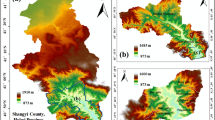Abstract
Debris flow is one of the most destructive phenomena of natural hazards. Recently, major natural hazard, claiming human lives and assets, is due to debris flow in the world. Several practical methods for forecasting debris flow have been proposed, however, the accuracy of these methods is not high enough for practical use because of the stochastic and non-linear characteristics of debris flow. Artificial neural network has proven to be feasible and useful in developing models for nonlinear systems. On the other hand, predicting the future behavior based on a time series of collected historical data is also an important tool in many scientific applications. In this study we present a three-layer feed-forward neural network model to forecast surge of debris flow according to the time series data collected in the Jiangjia Ravine, situated in north part of Yunnan Province of China. The simulation and prediction of debris flow using the proposed approach shows this model is feasible, however, further studies are needed.
Similar content being viewed by others
References
ARATTANO M, SAVAGE W Z, 1994. Modeling debris flows as kinematic waves [J]. Bull. Int. Assoc. Eng. Geol., 49 (Apr.):3–13.
CHENG-LUN S, SHVAN-DENG J, YUAN-FAN T, 1996. A numerical simulation of debris flow and its application [J]. Natural Hazards, 13(1): 39–54.
FAN Chu, 1994. 1-D steady numerical modeling of debris flow [J]. Dynamics & Application, 16(1): 50–52. (in Chinese)
GALLAGHER K, SAMBRIDGE M, 1994. Genetic algorithms: a powerful tool for large-scale nonlinear optimization problems [J]. Comput. & Geosci., 20(7/8): 1229–1236.
HUNT B, 1984. Dam-break solution [J]. J. Hydraulic Engineering, 110(6): 675–685.
HUNT B, 1994. Newtonian fluid mechanics treatment of debris flows and avalanches [J]. J. Hydraulic Engineering, 120(12): 1350–1363.
HUNTTER K, KOCH I, PLUSS C et al., 1995. The dynamics of avalanches of granular materials form initiation to runout [J]. Part II. Experiments, Acta Mech, 109(1–4):127–165.
IVERSON R M, 1997. The physics of debris flows [J]. Rev. Geophys., 35(3): 245–286.
JOHNSON A M, 1965. A model for debris flow [D]. Pennsylvania: Pennsylvania State University Park.
LAIGLE D, COUSSOT Ph, 1997. Numerical modeling of mudflows[J]. J. Hydraulic Engineering, 123(7): 617–623.
MACEDONIO G, PARESCHI M T, 1992. Numerical simulation of some lahars form mount St. Helens [J]. J. Volcanol. Geotherm. Res., 54(1–2): 65–80.
NI Jin-ren, LIAO Qian, QU Yi-zhong et al., 2000. An Euler-lagrangian model for non-continuous debris flow: I Theory [J]. J. Natural Disasters, 9(3): 8–14. (in Chinese)
NI Jin-ren, WANG Guang-qiang, 1998. Two-phase flow construct model on debris flows [J]. Acta Geographica Sinica, 53(1): 66–76. (in Chinese).
SAVAGE S B, 1984. The mechanics of rapid granular flows [J]. Adv. Appl. Mech., 24: 289–366.
SAVAGE S B, HUTTER K, 1989. The motion of a finite mass of granular material down a rough incline [J]. J. Fluid Mech., 199(Feb): 177–215.
SUWA H, 1988. Focusing mechanism of large boulders to a debris flow front [J]. Trans. Jpn. Geomorphol. Union, 9(1): 151–178.
TAKAHASHI T, 1981. Debris flow in prismatic open channel [J]. J. Hydrol. Eng., 106(3): 381–396.
TANG Chuan, 1994a. A preliminary study on 2-D debris flows numerical modeling method [J]. Hydrology & Engineering, 21(5):1. (in Chinese)
TANG Chuan, 1994b. Study on deposition and danger district of debris flows [J]. J. Water & Soil Conservancy, 8(1):45–50. (in Chinese)
WANG Yu-yi, FEL Xiang-jun, CHEN Rui, 2000. A modified rheological model of natural debris flows [J]. Chinese Science Bulletin, 45(8): 743–748.
WEN Ke-jun, LU Xun-xian, XIE Bao-yuan et al., 2001. Forecast on neural network and debris flow [J]. J. Xinjiang Agricultural University, 24(3): 54–58. (in Chinese)
YANO K, DAIDO A, 1965. Fundamental study on mudflow [J]. Bull. Disaster Prev. Res. Inst., 14: 69–83.
YU Bing, 1996. A numerical modeling of gully debris flows [J]. J. Mountain Research, 14(4): 255–258. (in Chinese)
ZHANG Jun, XIONG Gang, 1997. Data Collection of Knematics Observation of Debris Flows in Jiangjia ravine, Dongchuan [M]. Beijing: Science Press. (in Chinese)
Author information
Authors and Affiliations
Additional information
Foundation item: Under the auspices of the National Natural Science Foundation of China (No. 40025103)
Biography: WANG Xie-kang (1970–), male, a native of Ji’an City of Jiangxi Province, associate professor, specialized in river dynamics and nonlinear science
Rights and permissions
About this article
Cite this article
Wang, Xk., Huang, E. & Cui, P. Simulation and prediction of debris flow using artificial neural network. Chin. Geograph.Sc. 13, 262–266 (2003). https://doi.org/10.1007/s11769-003-0028-1
Received:
Issue Date:
DOI: https://doi.org/10.1007/s11769-003-0028-1




